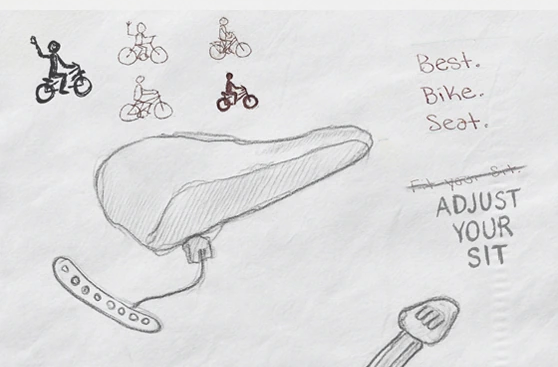
Part 1: The Spark
Share
The Spark: A Simpler, Smarter Seat
With an engineering background and decades in manufacturing, I set out to design a seat I couldn’t find. Early in the journey, I contacted a patent attorney, who strongly recommended I perform a patent search. I paid for the search and reviewed more than 40 different patents for adjustable bike seats. Most of the patents had designs that were overly complicated and never made it to market, but the exercise was invaluable. Reading through those 40-plus patents was like taking a class in bike seat design, and it validated the need for a seat with an adjustable width.
From there I went through several iterations, all of which shared a core idea: two seat halves that pivot at the front and move independently at the back.

First concept: threaded rod adjusted the seat halves.
The first concept used a threaded rod that the rider would rotate to move the seat halves. The design would either require a tool or include some sort of knob the user could turn. I quickly discarded this idea. The threaded components were complicated—the back of the seat moves in an arc, which meant several extra parts would be required to make a threaded connection work. The threaded rod would also have been a load-bearing component, raising concerns about flexing and long-term durability. I even had some conceptual drawings made of this design, but ultimately I shelved it.

Second concept: A lift–turn–reseat design with serrated seat halves engaging an arced guide rail.
The second concept was a lift–turn–reseat design. In this version, the back of each seat half had serrations that engaged with serrations on an arced guide rail. To adjust the seat, the rider would slightly lift the rear of the seat halves to disengage them, slide them to a new position, and release. It was much simpler, but it came with two problems: it required an additional component to lock the halves in place so they wouldn’t shift mid-ride, and it relied on flexing the seat halves themselves (a metal flex band sat in the middle of each half). I wasn’t thrilled with the idea, but before abandoning it I showed it to my brother-in-law. His comment—“You need a quick release device to make that work.”—was my epiphany moment.
The third concept became the final design. I was already familiar with two types of quick-release devices: spring plungers and cam levers. My current pending patent covers both. I opted for spring plungers, since I was concerned that riders might “skin their knuckles” against the seat post, reflector, rack, or anything else near the rear of the bike if they had to operate a cam lever. Spring plungers solved the problem: simple, safe, and reliable.
I sketched the seat I couldn’t find: two halves that pivot at the front and slide independently at the back, locking into place with spring-loaded plungers. No tools. Pull, slide, click. Repeat.
This was the moment the idea became a plan: keep the mechanism simple, make adjustments fast, and build it for everyday riders.
